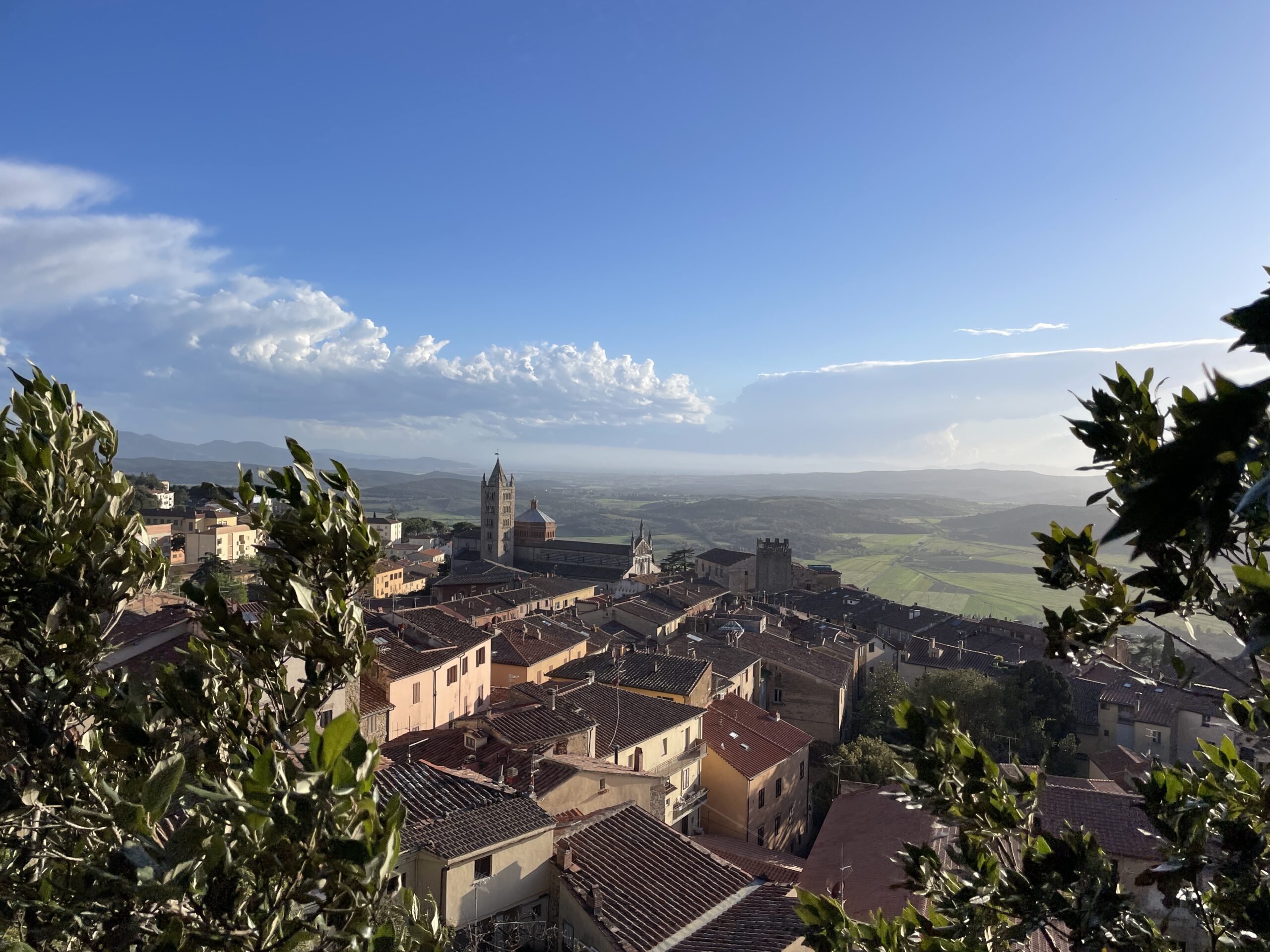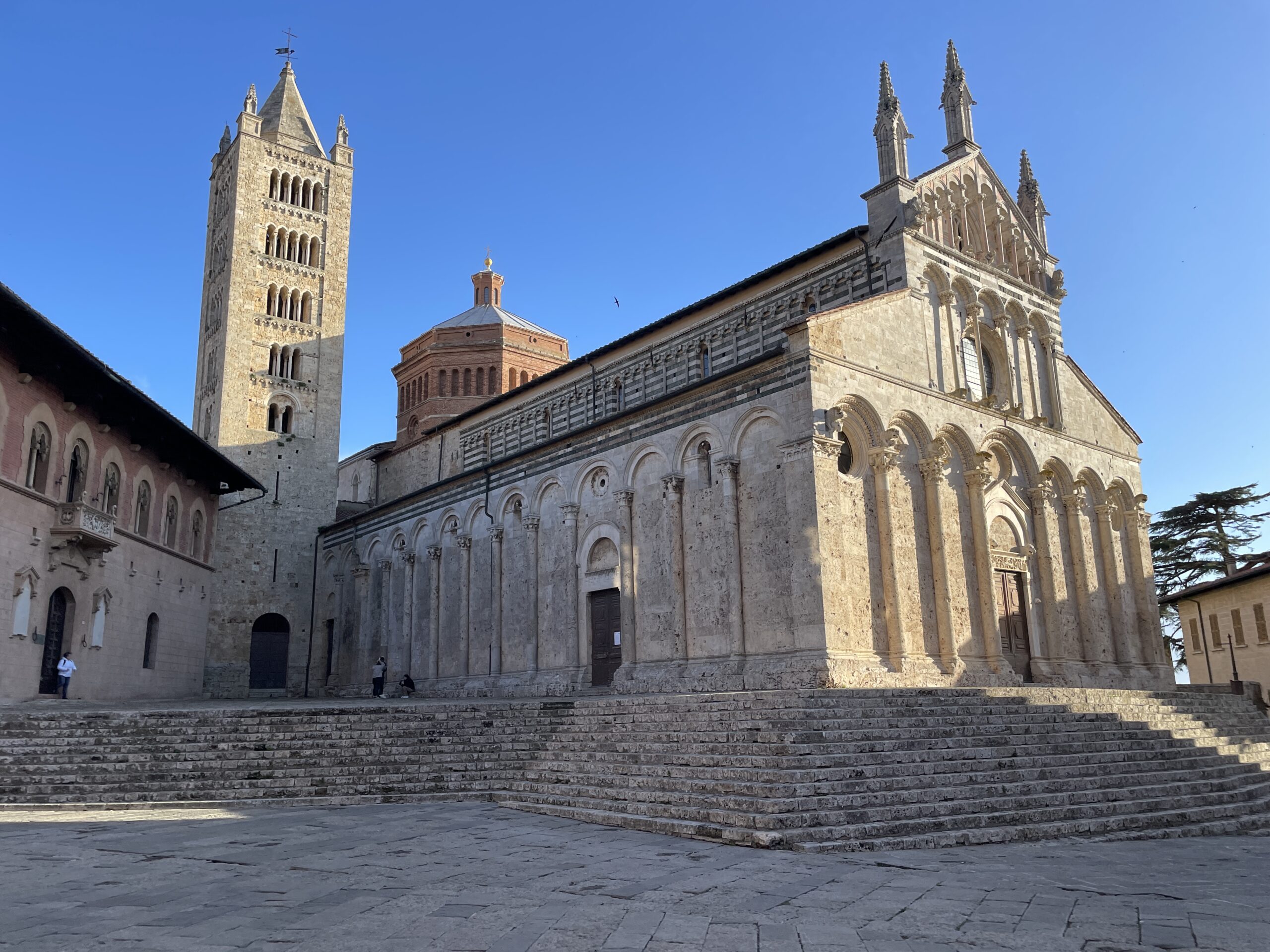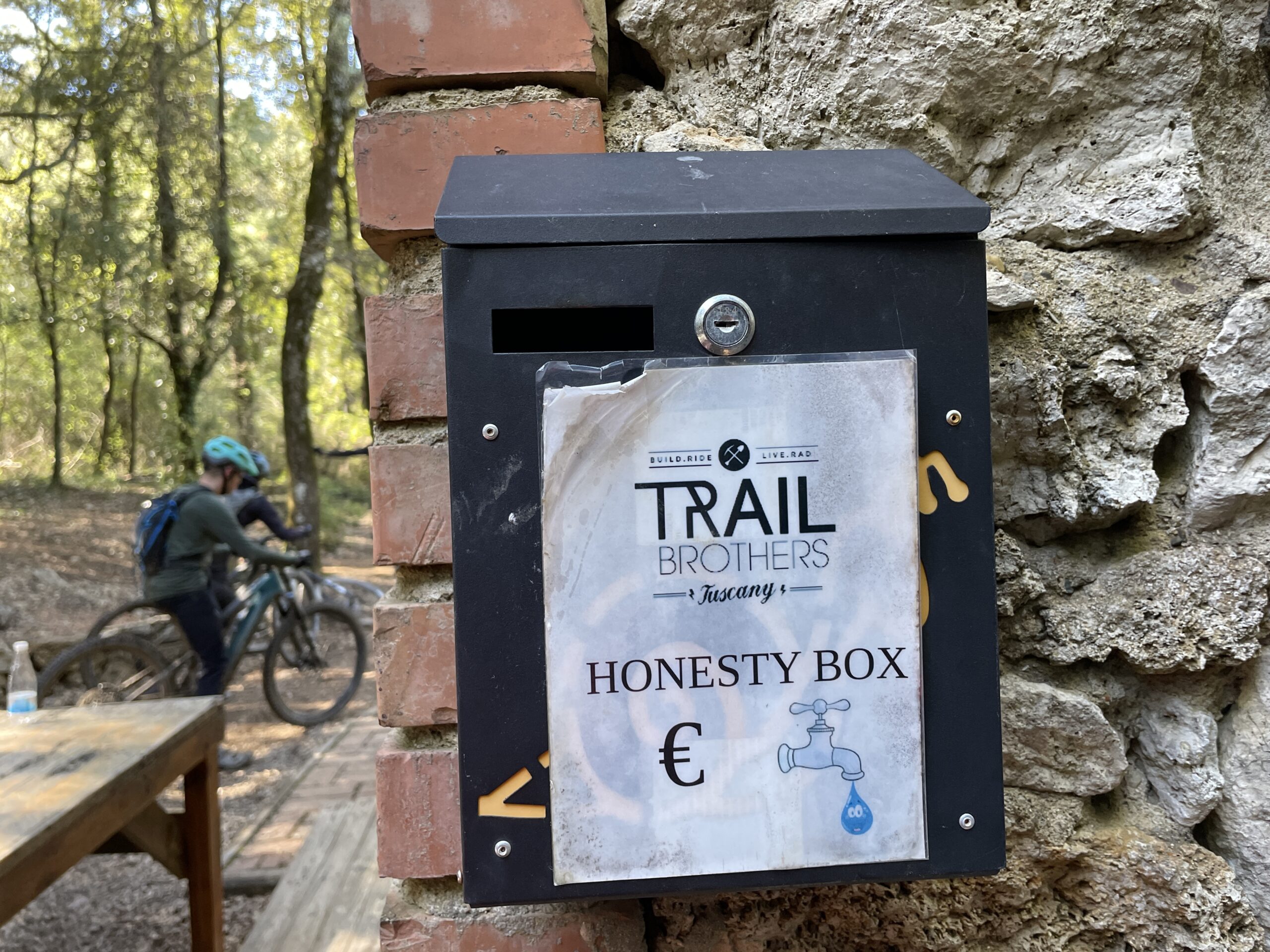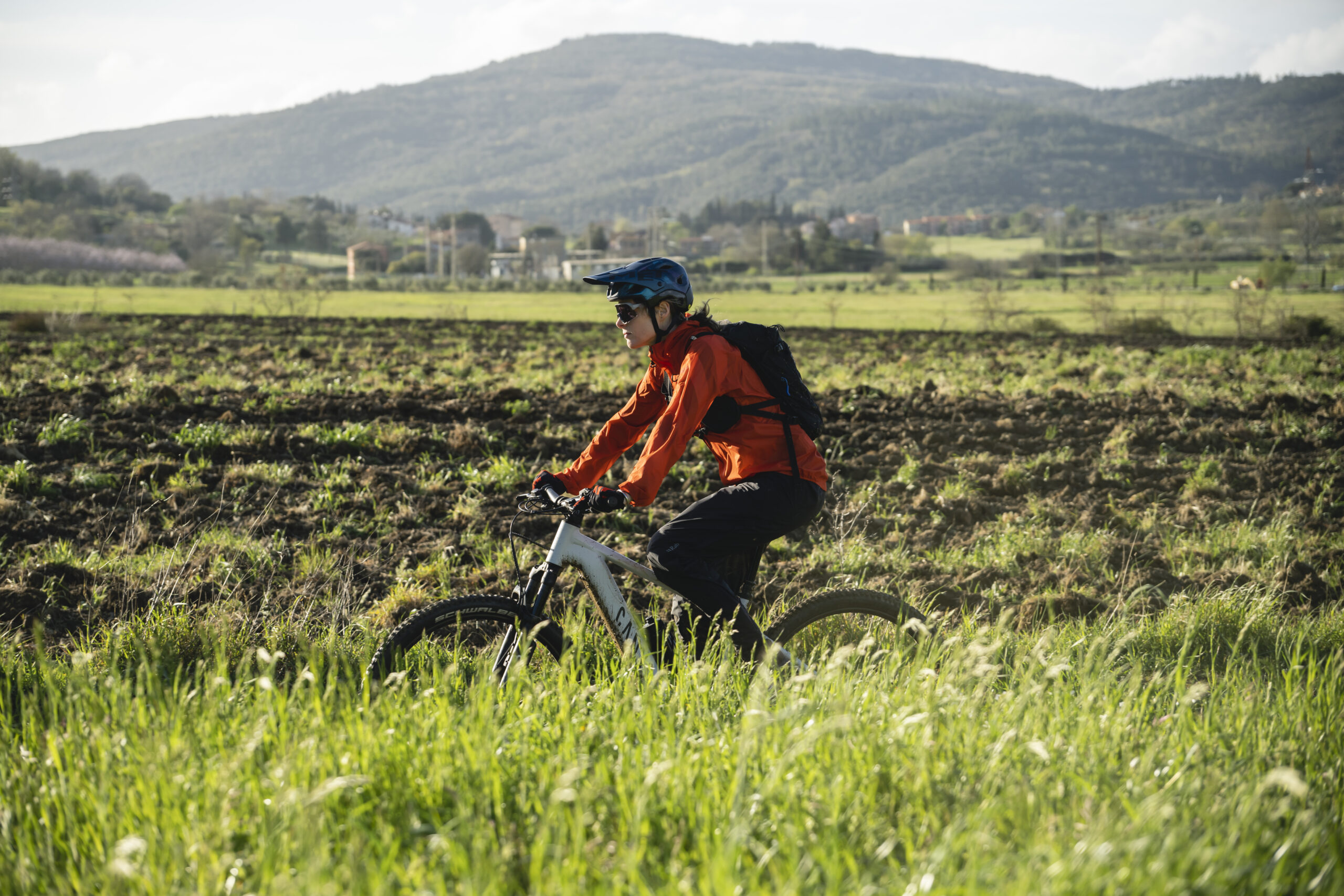Hannah explores the hillsides of Tuscany, where European mountain bikers are busy having their holidays without you.

Words by Hannah, pictures by Hannah or as credited.
In my mind’s eye, Tuscany is where middle-class families go for summer holidays in villas. Parents in crisp white shirts and Land’s End shorts and chinos sip red wine while Boden-attired children splash in turquoise tiled pools. Olive groves, vineyards, shades of terracotta, burnt umber, ochre and other paint chart shades of brown and orange.


Instead, it is green. Greens of every shade, with highlights of yellow (some sort of brassica plant?) and pink blossoms (cherries or chestnuts maybe?). For the first hour or so heading north from Rome, there’s a distinct lack of cute villas – but there are some pylons in interesting European shapes. We pass a turquoise pool – preformed, on its side, strapped to a truck in a rest area beside the (very smooth) autostrada. There are also hints of the creamy gravel that paves the Strade Bianchi, for which the area is perhaps best known in cycling circles.
Latest Singletrack Merch
Buying and wearing our sustainable merch is another great way to support Singletrack
Citadel central


The autostrada begins to disintegrate as the houses get posher. A 90km speed limit sign is followed immediately by a sign warning that the edges are crumbly. The landscape gets hillier, in an unfamiliar way. There are lots of pointy hills, sprouting up from the land below. Or were they dolloped there like butter icing that never got smoothed out? Suddenly everything feels very Italian. There are vineyards, some old with aged stalks like knurled fists on thick arms raised to the sky. Others are young, delicate stalks with years of growth ahead of them. Strange mushroom-like fir trees are everywhere too, with no lower branches, just a brush head of piney spikes up the top. Lollipops of blossom on similarly bare stalks are planted in evenly spaced rows, and the landscape is punctuated by slim and pointy, dark green Italian cypress, like leylandii with manners. Atop many of these hills are ancient-looking villages – citadels perhaps? – each with some sort of fortified or tower-like central building and old towns clinging on to their skirts. I wonder whether the previous inhabitants of this area were perhaps a bit fighty.

On one of these pointy hills lies Massa Marittima, and a 140km trail network developed and maintained by the ‘Trail Brothers’, the trail-building crew of Bike Service Massa Marittima. If you see it, you can ride it, thanks in no small part to the relationship they’ve built with landowners and neighbours. Mountain bikers are seen as good for business, and everyone seems keen to welcome them to the area – although not disturbing the neighbours too much is appreciated. The Canyon trails (there’s an uphill and downhill pair, each around 1km long) gained such popularity that they’ve built an extension onto the end of the descent, not to extend the fun, but to encourage riders sharing the stoke with whoops and high fives to do so a little further on, in a field, rather than in woods right beside an otherwise peaceful and secluded house.



The trails here are open all year unless there is snow. There are some individual trail closures during hunting season from 1st November to the end of January, which are agreed between the hunters and the Bike Service crew. All the trails are free to access, but of course, Bike Service Massa Marittima would be happy to take your money. You can hire one of their fleet of Canyon bikes (electric or otherwise, mountain or otherwise), make use of their rather gorgeous bike shop that nestles below the ancient town square, or go all-in with a guided ride or uplift day on Monte Arsenti. Even if you’re totally independent and happy to fend for yourself, signs around the hillside and the Trail Brothers’ cabin in the woods invite you to make a donation to help with trail maintenance. I find myself hoping that one day such donations may result in a toilet – out here, there are only bushes.

Euro secret
If local goodwill has helped welcome riders to the area, corporate sponsors have helped add to the facilities that greet them. Nino Schurter is practically a local, and a regular visitor to trails and family in the area – and this connection with Scott helped bring the area to the industry’s attention. More recently Canyon and Crank Brothers have both sponsored trails on the hill, and the business also receives significant support from Leatt and Pirelli. The location draws many tourists from Germany and Switzerland, but apparently Italians are now getting more and more into mountain biking, and also coming to the area. In the bike industry, it’s become a favourite spot for product launches – with a great and varied trail network, plus the relative proximity of Rome and Pisa airports, it offers a base suitable for revealing a variety of bikes to the world. Among the mountain bikers of the UK, however, the hills of Tuscany seem to have made little impression – perhaps overshadowed by the big mountain destinations with their chairlifts and World Cup tracks.




This oversight is their loss, however. While the hills here aren’t mountains, they offer up descents of a length rarely seen in the UK – you can expect to be descending without pause for 3km or more. Not only that, but with plenty of variety you’ll never find yourself wondering if there’s more to life than pointing your front wheel downhill. Steep sections and tight turns give way to swooping flow, just at the point where you’re not sure you can hold on any more, before dropping again through more steeps. There are the apparently barely tickled trails, some of which go back to the days when medieval miners worked underground to extract iron pyrite and coal. Even the purpose-built mountain bike trails go back a fair ways – we ride one trail that has been there for thirty years – it would be quite a thing to ride on a mountain bike of that era. Props to those who built it! Fire road climbs are linked by singletrack that’s barely more than a clear patch between the dense shrubbery on the hillside, then drop into steep chutes and loose ruts through rock or drifting shale. Valley floor trails wend their way through grassy meadows, and our guides explain that once upon a time all this was marshland. The hillside towns were not just for security – who wants to live in a swamp? Drainage works were started in the 18th century and eventually the infrastructure was finished after the Second World War. Now the swamps are gone and replaced by fields that play host to broad bean crops and increasing numbers of vineyards.



The bountiful nature of the area is evident as we arrive hungry and thirsty atop a minor hillock in the area for lunch at the Agriturismo Il Felciaione. These eateries that also have rooms showcase what the area has to offer the stomach and everything served – right down to the selection of fizzy drinks – is local. Cheese, meats, crusty breads, roasted vegetables, pesto and salads are spread out for us to tuck into, and we’re reminded by our hosts that this is just the first course – pasta is to follow. If there was a dessert, I don’t remember, having slipped into a food coma only to be jolted awake again by a final course of intense espresso coffee. The Italians don’t hold much truck with drinking cappuccino after 10.30 in the morning, but you can expect to end every meal with espresso – even if that is dinner at 11pm.

Miles of options
Even if you deploy e-bikes (and if you want to ride multiple descents on multiple days you may well wish to do so, unless you are in training for something, like the SAS maybe), you will likely find yourself perfectly capable of polishing off a hearty agriturismo lunch, only to put another three-course, carb-laden extravaganza into you again in the evening. With the exception of that late-night espresso, I’d urge you to take every (non-alcoholic) drink you’re offered. Even in the cool and damp-to-soaking weather that I experienced, the hours of pedalling had me chasing rehydration. With e-bikes reducing the need to sit around at the top of a climb to recover, I found myself almost constantly on the move, leaving only the fire roads where I could take on board water. Anything pointing down or along was wriggly enough or steep enough that two hands were required on the bars at all times. Carafes of wine appeared at every meal too, but I opted to skip the mid-ride glass of red in favour of clarity of focus on the trails.


More leisurely riding is available – it’s not all red and black trails. Indeed, take things at a slower pace and there’s plenty of fun but non-lethal riding to be done. In fact, the historic trails given a tickle here and there lend themselves very well to wheels on the ground riding. Mandatory drops and jumps are few and far between, and there are always go-rounds – though sometimes the easy lines switch sides, so stay alert. There are also miles and miles of gravel roads to be ridden – spin your way up to an old town, explore the cobbled streets and town walls, maybe take in a coffee and pastry, then cruise back down another gravel track. It’s perfectly possible to avoid the tech, but if you want to avoid the hills you’re also going to miss out on all the sights of the old towns. The hills are where the action is.

It’s not just Massa Marittima that has recognised the benefits that trail riders can bring to the area. There’s another huge trail network just another lumpy bump of a hill away, towards the coast. Scalina is yet another hillside town, from where you can access yet more trails. The soil and rocks here have a different feel, with grippier sandstone and well-draining loam in contrast to the limestone and shaley soils of the Massa Marittima bike park area. This area is covered by different access rules and different guides. Some of the trails here host races and trail closures should be observed. Routes vary between feeling like you’re out exploring the woods, to eyeballs out, rocky slot tech. There’s a very Wharncliffe feel to some of the trails – although I’ve never seen a string of wild boar piglets cross the trail in Sheffield. Others feel hard-baked and much more Mediterranean, with scented shrubs and stunted trees providing a backdrop. All of them have that feeling of having been ridden in rather than built, and some of the signs of erosion suggest that these trails are forever changing in character and trickiness.


Lose yourself and switch off
Scalina feels more like some trails on a hill than the signposted and constructed routes on Monte Arsenti, which has a definite bike park feel. Regular signs along the Monte Arsenti trails ensure that if you need emergency help, you’ve got an easily identifiable location. Apparently these can also help you find your way, but it appeared fairly cryptic to me. The trails cross fire roads, and I lose my sense of direction completely, having no sense of which way would lead back to the Trail Brothers’ hut, only to later discover that the layout is quite simple. It’s just that all the twists and turns in the woods, coupled with the length of the descents, throw out my inner compass. Scalina throws me even more – after the ride I am completely unable to locate which trail was my favourite (and almost unable to lift an emergency coke to my lips). I try describing it to the guide: “The soil was orange and rocky. There were lots of ruts, and a false right-hand fork, and…” He suggests it was called Carbonai, but I’m about 99% sure that was my second favourite trail because I think that was the one where we did need to take the right-hand fork.




In March when I visit, temperatures are cool to pleasantly warm – and conditions occasionally epically (and unseasonably, I’m told) wet. Despite my motor assistance, I spend plenty of time with my heart pounding and lungs panting. I can’t imagine trying to tackle these routes in the heat of summer and under my own steam – it would surely be a case of one climb, one descent, and then back to melt in the sun with a recovery gelato. Exploring alone would require a different mindset – an acceptance that you were going to see less of the trails, and go home with plenty still to return to. A guide – and rental e-bike – might seem like a luxury, but if a holiday is about downtime, and treating yourself, then why not? The opportunity to switch off from route finding, the confidence in having the backup of a guide with extra tubes, and the knowledge that you’re seeing the best possible trails all strung together seems to me like an attractive option.

I’ve always been a fan of going on holiday to places where other British people don’t usually head en masse. It feels more foreign and, dare I say, quieter? Somehow it’s easier to ignore the chatter around you when you don’t understand it – the people at the next table might be talking nonsense about reality TV or politics, but if you don’t speak the language you remain blissfully ignorant. The trails here – and the food, and the slightly crumbling historic villages – are deserving of your attention. Come and sample them before everyone else does.
Disclosure: Hannah’s travel and accommodation costs were covered by Canyon.




